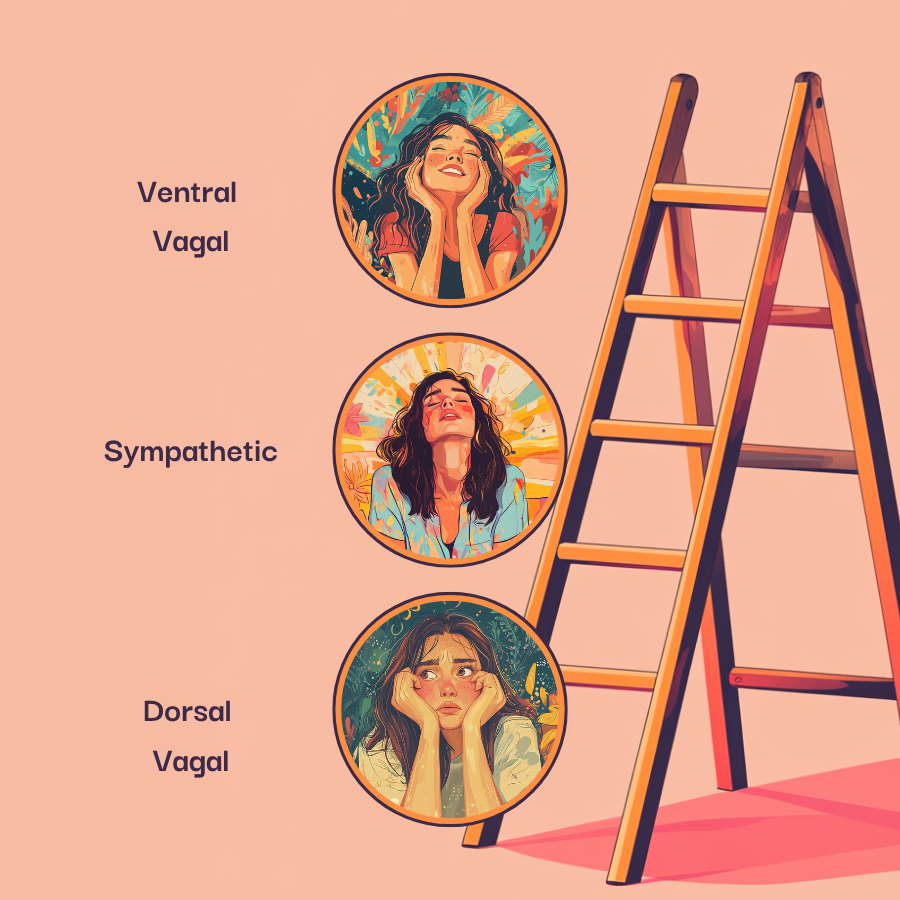Ever feel like your emotions have a mind of their own, pulling you deep into stress and overwhelm, or states of anxiety and despair? Believe it or not, these fluctuations aren’t just the result of an irritating boss or an ex’s late-night texts—it’s your nervous system at work.
Your body’s internal wiring plays a huge role in influencing your emotions, behavior, and overall well-being, and it all starts with something called the vagus nerve. (And yes, that’s pronounced “Vegas,” as in “Viva Las.”)
In this article, we’re going to break down Polyvagal Theory—a concept that helps you understand how your nervous system reacts to the world around you. Whether you’re dealing with everyday stress or recovering from trauma, getting a handle on this theory can be a game-changer for regulating your nervous system. We’ll explore the different states your nervous system can slip into, and more importantly, how you can learn to move between these states with greater ease and flexibility—so you don’t stay stuck in unhelpful moods.
Who Created Polyvagal Theory?
Dr. Stephen Porges, a neuroscientist, is the brain behind Polyvagal Theory. He introduced this theory in the 1990s, flipping the script on how we understand the autonomic nervous system. Thanks to his work, we now have a clearer picture of why we sometimes feel safe, have a freak out, or just shut down.
What is Polyvagal Theory?
Polyvagal Theory is like a roadmap for understanding how your body and brain team up to respond to life’s challenges. In the simplest terms, Polyvagal Theory explains how and why our nervous system shifts through different states—whether we’re facing stress, feeling safe, or experiencing something in between.[*]
Let’s break it down a little.
Your nervous system has three main response modes, and each one plays a different role in how you react to the world around you:
- The “fight or flight” response, or what Polyvagal Theory calls “Sympathetic,” kicks in when you’re in danger, mobilizing your body to either face the threat or escape from it. It’s your body’s way of saying, “Let’s get the hell out of here.”
- Then there’s the “collapse” response, known in Polyvagal terms as “Dorsal Vagal.” This state of immobilization takes over when things feel too overwhelming, leaving you shut down, disconnected, or just plain numb.
- Finally, there’s the “social engagement” response, also known as the “Ventral vagal” state. This is where you want to be to feel safe and connected. In this state, you’re relaxed, open to interactions, and able to engage with others in a healthy way—think easy conversations, smiles, and warm eye contact.
These three states aren’t fixed; they’re more like gears your body shifts through depending on what’s happening around you. These states can also blend, and depending on your level of regulation, these blended states can feel very different.
Here’s an example of blended states at play in the same situation, for a regulated vs. dysregulated nervous system:
- Regulated: You’re playing beach volleyball with your bff’s. You’re happy and chill, enjoying the summer vibes and feeling socially connected. But you’re also mobilized and primed for action—playing to win. You’re blending mobilization with a ventral vagal state, and it feels great.
- Dysregulated: In a dysregulated nervous system, your internal wiring may be a little off, causing you to perceive the same situation differently. You feel socially anxious on the beach. It’s busy, and you’re hypervigilant about everything around you. The noise is overwhelming, the sun feels too bright, and you’re uncomfortably hot. You’re so overwhelmed that you feel exhausted and sit the game out. Here, you’re blending mobilization with immobilization, and it feels terrible.
Polyvagal Theory helps us understand that by becoming aware of these different states, we can start to better manage our health, emotions, and relationships. It’s basically like having a user manual for your nervous system.
The Vagus Nerve
So what’s driving these shifts in state? The vagus nerve. This major nerve runs from your brainstem down to your gut, acting as a communication superhighway that influences everything from your heart rate to digestion to your breathing.
But it’s not just about the physical stuff—this nerve also plays a huge role in how you feel emotionally and how you respond to stress.[*] When the vagus nerve is in good shape, it helps you stay calm, grounded, and socially connected. It’s a key player in Polyvagal Theory.

How Does Nervous System Dysregulation Relate to Polyvagal Theory?
If you’ve experienced any level of trauma or chronic stress, your body may be stuck in a state of fight or flight.[*] The vagus nerve, which normally helps us feel calm and connected, gets out of sync. Instead of activating the social engagement system that allows us to pick up on cues of safety, we start to misinterpret neutral or even friendly signals as threats.[*]
This means your body is constantly on high alert, hypervigilant, and ready to face danger. When the “danger” you perceive is coming from a nervous system under pressure, you start to misinterpret typically ‘safe’ things as threats. Things like a crowded room or a trip to the movies.
Over time, this can leave us trapped in a state of dysregulation, where our body responds inappropriately to non-threatening situations.
This disconnect makes it hard to feel safe or engage with others, causing us to miss out on those crucial moments of connection that keep us grounded and resilient.
So how do you break this fight or flight loop?
One of the first and most crucial steps to healing a dysregulated nervous system is awareness. Polyvagal Theory helps us develop awareness of what is happening in our nervous systems, by mapping out the different states it can get stuck in:
- Ventral Vagal State (Social Engagement Mode)
- Sympathetic State (Fight-or-Flight Mode)
- Dorsal Vagal State (Shutdown Mode)
Understanding where you are on this “ladder” of emotions can help you pinpoint why you feel the way you do so you can guide yourself back to a more balanced state. Keep reading to learn more about the Polyvagal Ladder.
The Social Engagement System
The social engagement system is like your body’s way of saying, “Hey, I’m cool and ready to connect!” It’s a key part of Polyvagal Theory and is the state when you’re feeling safe and relaxed (remember the beach volleyball scene?).
When your body’s in this Ventral Vagal State (or social engagement mode), you’re using subtle cues like eye contact, facial expressions, and tone of voice to interact smoothly with others. This state makes you more open, approachable, and ready to build positive connections.
And it works both ways. When you are in a ventral vagal state, you’re better at picking up on friendly signals and cues from others too. And your nervous system reads these subtle signs as cues of safety.
But when stress or trauma enters the scene, this system can get knocked out of gear. Instead of picking up on friendly signals and feeling safe, you might withdraw or misread social cues.
If you’re stuck in fight-or-flight mode or feeling overwhelmed, it’s tougher to tune into the signals that say everything’s okay. So, understanding and supporting your social engagement system (via your nervous system) can help you stay grounded, connected, and better at navigating life’s ups and downs.[*]
Faulty Social Cues and Neuroception
So, what’s going on when your body starts misreading safe social signals? That’s your neuroception in action.
Neuroception is your brain’s built-in safety scanner, constantly checking for threats or safety without you even noticing. When this system gets out of whack, you might start seeing harmless social cues as threats or feel anxious in situations that should be calming. It’s like having your internal alarm system cranked up too high, making you more on edge and more likely to misinterpret others’ intentions.
See how it’s all coming together?
- Prolonged stress and trauma throw your nervous system off balance
- This leads to faulty neuroception and an out-of-sync vagus nerve response
- You stop picking up on safety signals in your environment
- You struggle to regulate yourself and connect with others
What is the Polyvagal Ladder?
The Polyvagal Ladder is a handy way to visualize and map where your nervous system is at any given moment. Picture a ladder with three rungs:
- Top Rung: Ventral Vagal (Social Engagement Mode): Here, you feel safe, connected, and calm—ready to face the world with confidence.
- Middle Rung: Sympathetic (Fight or Flight Mode): On this rung, you’re alert and ready to deal with challenges. It’s useful in short bursts but exhausting if you’re stuck here too long.
- Bottom Rung: Dorsal Vagal (Shutdown Mode): This is where you feel disconnected and numb, like your body is shutting down to protect you from overwhelming stress.
Other practitioners suggest mapping your states by using colors – such as red for fight or flight, or blue for shutdown mode.

The Importance of the Polyvagal Ladder
The Polyvagal Ladder isn’t just a fancy term; it’s a super handy tool in therapy and to practice in everyday life – especially for folks working through trauma and nervous system dysregulation.
It helps you map out where you are on the ladder of your nervous system’s states—whether you’re feeling calm, stressed, or overwhelmed. By regularly checking in on where you’re at and how you’re feeling, you start to get a better handle on your reactions and what might be triggering them.
This awareness can be a game-changer, helping you understand your body’s signals and find healthier ways to respond to stress. It’s all about gaining control, reducing self-blame, and discovering effective strategies for healing.
Moving Up and Down the Polyvagal Ladder
The aim isn’t just to climb the ladder but to move through the different states with more ease and flexibility. By figuring out where you are on the ladder, you can start to:
- Spot your triggers
- Find out what helps you reset
- Move through the emotions more easily
For instance, if you’re stuck in fight-or-flight, deep breathing or something calming might help you shift to a more balanced state.
If you’re in shutdown mode, gentle movement or connecting with someone could help you re-engage and feel more present.
It’s all about learning how to regulate your nervous system so you can navigate these states in a healthier, more adaptable way.
To get even more specific, here’s a handy Polyvagal Chart to map out where you are.
Polyvagal Therapy: How Do You Reset the Social Engagement System?
So, how do you shift gears when your nervous system is stuck in overdrive?
There are many ways that you can start regulating your nervous system that are rooted in Polyvagal therapy.
One that really gets to the core is the Safe and Sound Protocol (SSP), a therapy developed by Dr. Porges himself.
Think of SSP as a reset button for your nervous system. It’s a non-invasive, sound-based therapy designed to gently stimulate the vagus nerve via the muscles of the inner ear, helping your body move from a state of dysregulation back to a place of calm and safety.
You can read more about it here.
Polyvagal Exercises to Support Nervous System Dysregulation
Besides SSP, sticking with regular polyvagal exercises can really boost your resilience and make it easier to handle triggers and stress.
With time, these practices can lead to easier emotional regulation, better relationships, and a stronger overall sense of well-being. It’s all about building those inner resources so you can bounce back faster and feel more grounded.
Want to give your vagus nerve a little TLC? Here are some simple Polyvagal exercises to help you build a more resilient nervous system:
- Deep Breathing: Try the 4-7-8 breathing exercise. Breathe in through your nose for 4 seconds, hold your breath for 7 seconds, and then exhale slowly through your mouth for 8 seconds. This simple trick helps activate your parasympathetic nervous system, pulling you out of fight-or-flight mode and bringing a sense of calm.
- Humming or Chanting: Sounds a bit quirky, but humming or chanting can work wonders. Give the “OM” chant from yoga a shot or just hum a soothing tune. It stimulates your vagus nerve and can help you relax. Try it for a few minutes and notice how it calms you down.
- Cold Exposure: Splash some cold water on your face or take a quick cold shower. This little shock to the system can tone your vagus nerve and help regulate your nervous system. It’s a brisk way to reset and refresh.
- Gargling: Gargling with water might seem (and sound) odd, but it’s actually good for you! Try gargling for about 30 seconds a few times a day. It helps stimulate your vagus nerve, giving it a gentle workout and promoting relaxation.
- Yoga: Yoga is a great way to soothe your nervous system. Poses like Child’s Pose, Legs-Up-The-Wall, and Cat-Cow stretch are especially relaxing. Pair these poses with deep breathing to amplify the calming effect. For example, when you are in Child’s Pose, focus on slow, deep breaths to help your whole body unwind.
- Co-Regulating with Someone or a Pet: Spending time with a loved one or a favorite furry friend can be super soothing. Whether it’s cuddling with the cat or having a heart-to-heart with a friend, these interactions can help stabilize your nervous system.
Polyvagal Theory and The Safe and Sound Protocol in Trauma Recovery
Trauma can mess with your nervous system, leaving you constantly on edge and stuck in survival mode.[*] But Polyvagal Theory gives you a roadmap to make sense of it all.
By figuring out whether you’re in fight-or-flight mode or feeling shut down, you can start to find ways to get back to a place where you feel safe and connected. It’s all about tuning into your body’s signals and learning how to shift gears towards calm and connection.
And for those dealing with trauma, SSP can be a game-changer. The combination of supportive co-regulation from an SSP practitioner, the mapping of your autonomic nervous system ladder, and the gentle resetting of your vagus nerve can be life-changing.
Polyvagal Theory Debunked: What Do the Critics Say?
Like any theory that sits slightly outside the mainstream, critics would love to see Polyvagal theory debunked. Some skeptics argue that the theory oversimplifies the complexity of the nervous system or that it lacks enough hard scientific evidence to back up all its claims. Others question the exact pathways and mechanisms that Porges proposed.
So is Polyvagal Theory Evidence-Based?
Polyvagal Theory has definitely made a splash in the therapy world, but it’s still a bit of a mixed bag in the science community. Some parts, like how the vagus nerve helps with emotional regulation, are backed by solid research.[*][*][*][*] But other aspects, especially the finer details of how it all works, are still up for debate.
Even with the ongoing discussions, many people find Polyvagal Theory super handy for getting a handle on how their nervous system reacts. It’s like having a practical toolkit for managing stress and improving connections in everyday life, especially if you’re working with a therapist.
From a personal standpoint, I have yet to come across an effective nervous system healing protocol that does not riff off of Polyvagal theory in some shape or form. It’s a pretty logical concept that serves as a great starting point for many protocols, and here at RegulateCo, we have found it invaluable.
Polyvagal Theory breaks down how your nervous system drives your feelings, behavior, and the way you connect with others. Whether you’re dealing with stress, trauma, or just trying to make sense of yourself, this approach offers some real-life tools to help you handle whatever life throws at you.
So, where are you on the Polyvagal Ladder today? Figuring that out might be the first step to feeling more balanced, connected, and ready to take on the day.

